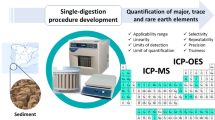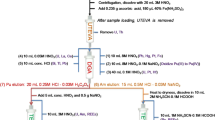Abstract
Purpose
The goal of this study was to develop a “green chemistry” alternative sample preparation method for elemental analysis of sediments using laser ablation inductively coupled plasma mass spectrometry (LA-ICP-MS) to avoid the need for acid digestions. The LA-ICP-PS data are used for sediment fingerprinting (sediment source determination) in order to locate sources of soil erosion and sediment transport into the Ruvu River Basin, the domestic water supply source for East Africa’s largest city, Dar es Salaam, in the United Republic of Tanzania.
Materials and methods
Suspended sediments were collected via filtration at multiple locations along the river for comparison to soil collected from potential sources throughout the watershed. The pellet method commonly used for soil requires approximately 0.5 g (Musil et al. Spectrochim Acta, Pt A: At Spectrosc 55:1747–1758, 2000; Bustamante et al. Spectrochim Acta, Pt A: At Spectrosc 57:303–309, 2002; Mikolas et al. Anal Bioanal Chem 374:244–250, 2002; Lee et al. Spectrochim Acta, Pt A: At Spectrosc 58:523–530Q1, 2003; Hassan et al. Spectrochim Acta, Pt A: At Spectrosc 63:1225–1229, 2008; Jantzi et al. Spectrochim Acta, Pt A: At Spectrosc 115:52–63, 2016). However, on average, less than 0.1 g of sediment was non-uniformly distributed and could not be separated from the filters on which they were collected. Therefore, a novel “filter pellet” method was developed in order to homogenize and pelletize these filter-bound specimens, requiring only 50 mg of sediment on an 86-mg cellulose nitrate membrane filter. A quantitative multi-element LA-ICP-MS analysis method was optimized for the filter pellets. A mixing model was then utilized to apportion the primary sources of sediment composing the suspended sediment samples.
Results and discussion
The analytical performance of the filter pellets was similar to that achieved with the soil pellets. An element menu of 17 elements was obtained with recoveries between 75 and 125%, precision of 10% or less (relative standard deviation), repeatability of 10% or less for duplicate analyses, and limits of detection in the ppb to low ppm range. A significant source of sediments was determined to be coming from an area of particular concern within the Mgeta Catchment of the Ruvu River Basin—the meta-anorthosite complex, which comprises less than 3% of the basin yet contributes up to 10% of the suspended sediment load in the Ruvu River.
Conclusions
A novel sample preparation strategy was developed in which sediments bound to filters were processed into pellets for analysis by LA-ICP-MS (and potentially LIBS). Quantitative multi-element LA-ICP-MS data were generated, of sufficient quality for use in sediment fingerprinting applications without the need for acid digestions. This paper describes the method development and LA-ICP-MS results of the filter pellet method and a brief exploration of the sediment fingerprinting results.




Similar content being viewed by others

References
Anastas P, Eghbali N (2010) Green chemistry: principles and practice. Chem Soc Rev 39:301–312
Anastas PT, Kirchhoff MM (2002) Origins, current status, and future challenges of green chemistry. Acc Chem Res 35:686–694
Arroyo L, Trejos T, Gardinali PR, Almirall JR (2009) Optimization and validation of a laser ablation inductively coupled plasma mass spectrometry method for the routine analysis of soils and sediments. Spectrochim Acta A At Spectrosc 64:16–25
Arroyo L, Trejos T, Hosick T, Machemer S, Almirall JR, Gardinali PR (2010) Analysis of soils and sediments by laser ablation inductively coupled plasma mass spectrometry (LA-ICP-MS): an innovative tool for environmental forensics. Environ Forensic 11:315–327
Borcard D, Gillet F, Legendre P (2011) Numerical ecology with R. Springer, New York
Bustamante MF, Rinaldi CA, Ferrero JC (2002) Laser induced breakdown spectroscopy characterization of Ca in a soil depth profile. Spectrochim Acta A At Spectrosc 57:303–309
Collins AL, Walling DE, Leeks GJL (1997) Source type ascription for fluvial suspended sediment based on a quantitative composite fingerprinting technique. CATENA 29:1–27
Davis CM, Fox JF (2009) Sediment fingerprinting: review of the method and future improvements for allocating nonpoint source pollution. J Environ Eng 135:490–504
Dearmont D, McCarl BA, Tolman DA (1998) Costs of water treatment due to diminished water quality: a case study in Texas. Water Resour Res 34:849–853
Dutton C, Anisfeld SC, Ernstberger H (2013) A novel sediment fingerprinting method using filtration: application to the Mara River, East Africa. J Soils Sediments 13:1708–1723
Dutton CL, Subalusky AL, Anisfeld SC, Njoroge L, Rosi EJ, Post DM (2018) The influence of a semi-arid catchment on suspended sediments in the Mara River, Kenya. PLoS One 13:e0192828. https://doi.org/10.1371/journal.pone.0192828
Gadgil A (1998) Drinking water in developing countries. Annu Rev Energy Environ 23:253–286
GLOWS (2014a) Climate, forest cover and water resource vulnerability in the Wami, Ruvu and Coastal River basins of Tanzania. Florida International University, Miami
GLOWS (2014b) Water atlas of the Wami/Ruvu Basin, Tanzania. Global Water for Sustainability Program at Florida International University, Miami
Hassan M, Sighicelli M, Lai A, Colao F, Ahmed AHH, Fantoni R, Harith MA (2008) Studying the enhanced phytoremediation of lead contaminated soils via laser induced breakdown spectroscopy. Spectrochim Acta A At Spectrosc 63:1225–1229
Horowitz AJ (1991) A primer on sediment-trace element chemistry. Open-file report, 2nd edn. United States Geological Survey, Denver, pp 91–79
Jantzi SC, Almirall JR (2011) Characterization and forensic analysis of soil samples using laser-induced breakdown spectroscopy (LIBS). Anal Bioanal Chem 400:3341–3351
Jantzi SC, Almirall JR (2014) Elemental analysis of soils using laser ablation inductively coupled plasma mass spectrometry (LA-ICP-MS) and laser-induced breakdown spectroscopy (LIBS) with multivariate discrimination: tape mounting as an alternative to pellets for small forensic transfer specimens. Appl Spectrosc 68:963–974
Jantzi SC, Motto-Ros V, Trichard F, Markushin Y, Melikechi N, De Giacomo A (2016) Sample treatment and preparation for laser-induced breakdown spectroscopy. Spectrochim Acta A At Spectrosc 115:52–63
Jones JI, Murphy JF, Collins AL, Sear DA, Naden PS, Armitage PD (2012) The impact of fine sediment on macro-invertebrates. River Res Appl 28:1055–1071
Kemp P, Sear D, Collins A, Naden P, Jones I (2011) The impacts of fine sediment on riverine fish. Hydrol Process 25:1800–1821
Laceby JP, Evrard O, Smith HG, Blake WH, Olley JM, Minella JPG, Owens PN (2017) The challenges and opportunities of addressing particle size effects in sediment source fingerprinting: a review. Earth-Sci Rev 169:85–103
Lee YL, Chang CC, Jiang SJ (2003) Laser ablation inductively coupled plasma mass spectrometry for the determination of trace elements in soil. Spectrochim Acta Part B At Spectrosc 58:523–530
Mikolas J, Musil P, Stuchlikova V, Novotny K, Otruba V, Kanicky V (2002) Infrared laser ablation study of pressed soil pellets with inductively coupled plasma atomic emission spectrometry. Anal Bioanal Chem 374:244–250
Musil P, Otruba V, Kanicky V, Mermet JM (2000) Determination of elements in agricultural soils using IR laser ablation inductively coupled plasma atomic emission spectrometry. Spectrochim Acta A At Spectrosc 55:1747–1758
Newcombe CP, Macdonald DD (1991) Effects of suspended sediments on aquatic ecosystems. N Am J Fish Manag 11:72–82
Onda K, LoBuglio J, Bartram J (2012) Global access to safe water: accounting for water quality and the resulting impact on MDG progress. Int J Environ Res Public Health 9:880–894
Parnell AC, Inger R, Bearhop S, Jackson AL (2010) Source partitioning using stable isotopes: coping with too much variation. PLoS One 5:e9672. https://doi.org/10.1371/journal.pone.0009672
R Core Team (2017) R: a language and environment for statistical computing. ver 3.4.3. R Foundation for Statistical Computing, Vienna
Venables WN, Ripley BD (2002) Modern applied statistics with S. Springer, New York
Walling DE (2005) Tracing suspended sediment sources in catchments and river systems. Sci Total Environ 344:159–184
Walling DE (2013) The evolution of sediment source fingerprinting investigations in fluvial systems. J Soils Sediments 13:1658–1675
Walling DE, Owens PN, Leeks GJL (1999) Fingerprinting suspended sediment sources in the catchment of the river Ouse, Yorkshire, UK. Hydrol Process 13:955–975
Wang H et al (2014) Water and wastewater treatment in Africa – current practices and challenges. Clean (Weinh) 42:1029–1035
Weihs C, Ligges U, Luebke K, Raabe N (2005) klaR analyzing German business cycles. In: Baier D, Decker R, Schmidt-Thieme L (eds) Data analysis and decision support. Springer-Verlag, Berlin, pp 335–343
Yanda PZ, Munishi PKT (2007) Hydrologic and land use/cover change analysis for the Ruvu River (Uluguru) and Sigi River (east Usambara) watersheds. WWF/CARE Dar es Salaam, Dar es Salaam
Acknowledgements
The authors would like to thank the Water Officer of the Wami-Ruvu Basin Water Board, Ms. Praxeda Kalugendo, for facilitating this research. Assistance was provided by the Global Water for Sustainability (GLOWS) team, specifically Mercy Mohammed, Lissvett Vergara, and Vivienne Abbott. James Renatus and Mr. Lema from the Ministry of Water and Irrigation and the Wami-Ruvu Basin Water Board assisted with sampling. The views expressed are those of the authors and do not necessarily reflect the official policy or position of the National Institute of Justice, the US Department of Justice, US Agency for International Development, or the US government. Names of commercial manufacturers are provided for identification purposes only, and inclusion does not imply endorsement of the manufacturer or its products or services.
Funding
Funding for this study was provided by the United States Agency for International Development (USAID) under the Tanzania iWASH program. Funding for SCJ was provided in part by the Doctoral Evidence Acquisition (DEA) and Dissertation Year Fellowships (DYF) at Florida International University (FIU) and by National Institute of Justice grant no. 2009-DN-BX-K252 to FIU.
Author information
Authors and Affiliations
Corresponding author
Additional information
Responsible editor: Rajith Mukundan
Rights and permissions
About this article
Cite this article
Jantzi, S.C., Dutton, C.L., Saha, A. et al. Novel “filter pellet” sample preparation strategy for quantitative LA-ICP-MS analysis of filter-bound sediments: a “green chemistry” alternative to sediment fingerprinting in Tanzania’s Ruvu River basin. J Soils Sediments 19, 478–490 (2019). https://doi.org/10.1007/s11368-018-2076-2
Received:
Accepted:
Published:
Issue Date:
DOI: https://doi.org/10.1007/s11368-018-2076-2



